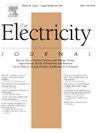基于新型逆最大功率点跟踪技术(iMPPT)的可变电源电压调整纳米电网能量转换优化方法
IF 2.2
Q1 Social Sciences
引用次数: 0
摘要
本文介绍了一种新的电源电压调整策略,该策略可以根据吸收功率确定最佳电压值。一种新的电压自动调节技术被称为逆最大功率点跟踪(iMPPT)。所提出的控制策略包括一种改进的最大功率点跟踪(MPPT)算法(更准确地说是P&O方法)。在这种情况下,改进的MPPT技术建立了由开关模式电源(SMPS)服务的消费负载的输入吸收功率的最小值。iMPPT通过改变主电源的输入电压来调节输入功率。服务负载通过执行自动电压调节功能(AVR)的接口电力电子转换器连接到可变电源。当自动调压变换器的输入功率最小时,可以达到输入电压电平的最优值。此时能量转换效率最大,与前端功率级相关的总体损耗最小。所提出的技术也可以被认为是一种最大效率跟踪(MET)方法。通过对开关电源(SMPS)的输入需求功率进行最大功率点跟踪算法的逆运算,当能量转换比(与给定负载电平相关)达到最大时,可以确定最优输入电压电平。在输入电压为350 V的同步降压变换器提供800 W输出功率的情况下,该方法可以将能量转化率从85%提高到10%左右。在这种情况下,回收的总功率大约为100w。本文章由计算机程序翻译,如有差异,请以英文原文为准。
Energy Conversion Optimization Method in Nano-Grids Using Variable Supply Voltage Adjustment Strategy Based on a Novel Inverse Maximum Power Point Tracking Technique (iMPPT)
This paper introduces a novel power supply voltage adjustment strategy that can determine the optimum voltage value based on the amount of absorbed power. The novel automatic voltage adjustment technique was called inverse maximum power point tracking (iMPPT). The proposed control strategy consists of a modified maximum power point tracking (MPPT) algorithm (more precisely the P&O method). In this case, the modified MPPT technique establishes the minimum value of the input absorbed power of a consumer load served by a switched-mode power supply (SMPS). The iMPPT adjusts the input power by modifying the input voltage of the main power supply. The served loads are connected to the variable power supply via an interfacing power electronics converter that performs the automatic voltage regulation function (AVR). The optimal value of the input voltage level can be achieved when the input power of the automatic voltage regulation converter is at a minimum. In that case, the energy conversion efficiency ratio is at a maximum, and the overall losses related to the front-end power stage are at a minimum. The proposed technique can also be considered a Maximum Efficiency Tracking (MET) method. By performing the inverse operation of a maximum power point tracking algorithm on the input demanded power of a switched mode power supply (SMPS), the optimum input voltage level can be determined when the maximum energy conversion ratio (related to a given load level) is achieved. The novel proposed iMPPT method can improve the energy conversion ratio from 85% up to approximately 10% in the case of an output power level of 800 W served by a synchronous buck converter at the input voltage level of 350 V. The total amount of recovered power in this situation can be approximately 100 W.
求助全文
通过发布文献求助,成功后即可免费获取论文全文。
去求助
来源期刊

Electricity Journal
Business, Management and Accounting-Business and International Management
CiteScore
5.80
自引率
0.00%
发文量
95
审稿时长
31 days
期刊介绍:
The Electricity Journal is the leading journal in electric power policy. The journal deals primarily with fuel diversity and the energy mix needed for optimal energy market performance, and therefore covers the full spectrum of energy, from coal, nuclear, natural gas and oil, to renewable energy sources including hydro, solar, geothermal and wind power. Recently, the journal has been publishing in emerging areas including energy storage, microgrid strategies, dynamic pricing, cyber security, climate change, cap and trade, distributed generation, net metering, transmission and generation market dynamics. The Electricity Journal aims to bring together the most thoughtful and influential thinkers globally from across industry, practitioners, government, policymakers and academia. The Editorial Advisory Board is comprised of electric industry thought leaders who have served as regulators, consultants, litigators, and market advocates. Their collective experience helps ensure that the most relevant and thought-provoking issues are presented to our readers, and helps navigate the emerging shape and design of the electricity/energy industry.
 求助内容:
求助内容: 应助结果提醒方式:
应助结果提醒方式:


